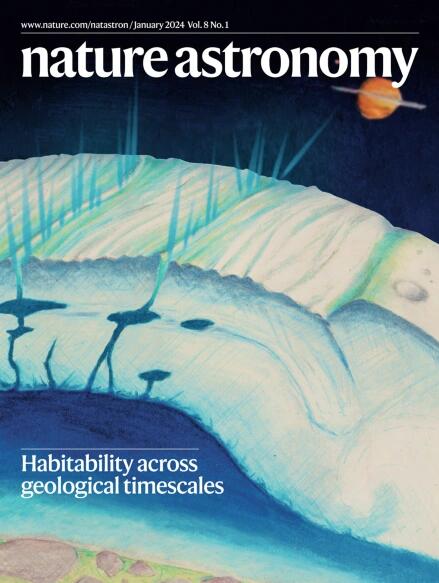一个富含气体的宇宙网由缺失的重子的分裂揭示出来
IF 14.3
1区 物理与天体物理
Q1 ASTRONOMY & ASTROPHYSICS
引用次数: 0
摘要
宇宙中大约一半的暗物质存在于坍缩的光晕中;明显少于一半的重子物质(质子和中子)仍然局限在晕中。一小部分重子存在于恒星和星系内的星际介质中。大多数是漫射的(<10−3 cm−3)和电离的(中性部分<10−4),位于星系间介质(IGM)和星系团、星系群和星系的晕中。众所周知,这种扩散电离气体很难测量,但对星系形成、天体物理反馈和精确宇宙学有着广泛的影响。最近,星系外快速射电暴(frb)的色散被用来测量宇宙重子的总含量。在这里,我们提出了一个大的宇宙学样本的快速射电暴源定位到他们的宿主星系。我们已经将缺失的重子划分为IGM,星系团和星系,提供了宇宙晚期重子丰度的测量,\({\varOmega }_{{\mathrm{b}}}{h}_{70}=0.05{1}_{-0.006}^{+0.006}\),其中Ωb是重子密度参数,h70是缩放的哈勃常数。我们的结果表明,有效的反馈过程可以耗尽星系晕并丰富IGM (IGM中的总重子分数为\({f}_{{\rm{IGM}}}=0.7{6}_{-0.11}^{+0.10}\)),这与宇宙学模拟中看到的富含重子的宇宙网情景一致。我们的研究结果可能会降低宇宙学中的“S8张力”,因为强反馈会导致物质功率谱的抑制。本文章由计算机程序翻译,如有差异,请以英文原文为准。


A gas-rich cosmic web revealed by the partitioning of the missing baryons
Approximately half of the Universe’s dark matter resides in collapsed halos; significantly less than half of the baryonic matter (protons and neutrons) remains confined to halos. A small fraction of baryons are in stars and the interstellar medium within galaxies. The majority are diffuse (<10−3 cm−3) and ionized (neutral fraction <10−4), located in the intergalactic medium (IGM) and in the halos of galaxy clusters, groups and galaxies. This diffuse ionized gas is notoriously difficult to measure, but has wide implications for galaxy formation, astrophysical feedback and precision cosmology. Recently, the dispersion of extragalactic fast radio bursts (FRBs) has been used to measure the total content of cosmic baryons. Here we present a large cosmological sample of FRB sources localized to their host galaxies. We have robustly partitioned the missing baryons into the IGM, galaxy clusters and galaxies, providing a late-Universe measurement of the cosmic baryon abundance, $${\varOmega }_{{\mathrm{b}}}{h}_{70}=0.05{1}_{-0.006}^{+0.006}$$ , where Ωb is the baryon density parameter and h70 is the scaled Hubble constant. Our results indicate efficient feedback processes that can deplete galaxy halos and enrich the IGM (total baryon fraction in the IGM is $${f}_{{\rm{IGM}}}=0.7{6}_{-0.11}^{+0.10}$$ ), agreeing with the baryon-rich cosmic web scenario seen in cosmological simulations. Our results may reduce the ‘S8 tension’ in cosmology, as strong feedback leads to suppression of the matter power spectrum. Using a large cosmological sample of FRBs, Connor et al. have located many of the Universe’s unseen baryons, finding that most reside in the diffuse intergalactic medium, not galaxies—confirming the strong astrophysical feedback seen in simulations.
求助全文
通过发布文献求助,成功后即可免费获取论文全文。
去求助
来源期刊

Nature Astronomy
Physics and Astronomy-Astronomy and Astrophysics
CiteScore
19.50
自引率
2.80%
发文量
252
期刊介绍:
Nature Astronomy, the oldest science, has played a significant role in the history of Nature. Throughout the years, pioneering discoveries such as the first quasar, exoplanet, and understanding of spiral nebulae have been reported in the journal. With the introduction of Nature Astronomy, the field now receives expanded coverage, welcoming research in astronomy, astrophysics, and planetary science. The primary objective is to encourage closer collaboration among researchers in these related areas.
Similar to other journals under the Nature brand, Nature Astronomy boasts a devoted team of professional editors, ensuring fairness and rigorous peer-review processes. The journal maintains high standards in copy-editing and production, ensuring timely publication and editorial independence.
In addition to original research, Nature Astronomy publishes a wide range of content, including Comments, Reviews, News and Views, Features, and Correspondence. This diverse collection covers various disciplines within astronomy and includes contributions from a diverse range of voices.
 求助内容:
求助内容: 应助结果提醒方式:
应助结果提醒方式:


